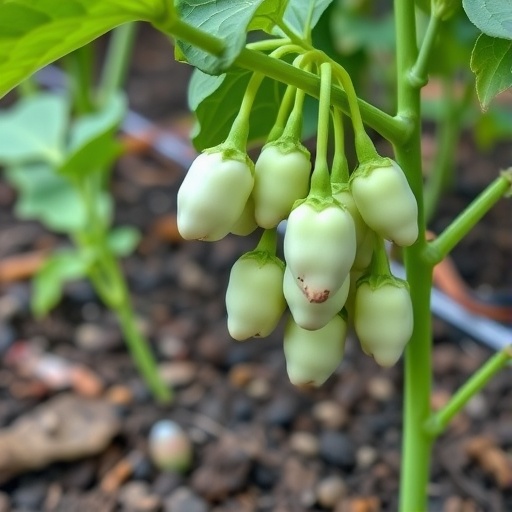In a groundbreaking study published in the esteemed journal Discov Agric, researchers have made significant strides in understanding and managing the faba bean gall disease, caused by the pathogen Physoderma viciae. This study focuses on a region in Meket district, North Eastern Ethiopia, where faba beans are a vital crop for local agriculture and food security. With increasing incidences of this disease, it has become critical to explore innovative strategies that combine host resistance and fungicide applications to mitigate the impact on crop yield and health.
The faba bean, or Vicia faba, is increasingly favored not only for its nutritional value but also for its role in agricultural systems due to its nitrogen-fixing ability. However, its susceptibility to various pests and diseases, particularly the gall disease caused by Physoderma viciae, poses a significant threat to production. The galls formed on the plant affect its growth and yield, with severe infestations leading to substantial economic losses for farmers. Agricultural scientists are now focused on understanding this complex pathogen-host interaction in order to develop effective management strategies.
In this study, the researchers extensively analyzed the genetic diversity of local faba bean varieties to identify potential resistance traits against Physoderma viciae. By breeding and selecting for these resistant traits, the researchers aimed to develop varieties that could withstand or minimize the effects of the gall disease. The integration of host resistance not only enhances the resilience of the faba bean crops but also reduces the reliance on chemical fungicides, which can have long-term environmental impacts and lead to issues such as pesticide resistance.
A multifaceted approach was taken, wherein the researchers conducted field trials to evaluate the efficacy of various fungicides in conjunction with resistant faba bean strains. The use of fungicides has long been a staple in crop disease management, but the study highlights the necessity of a combined approach—utilizing both resistant plant varieties and fungicidal treatments to maximize crop protection and yield. This study thus illustrates the potential for optimizing disease management practices through an integrated pest management ideology.
The field trials were meticulously designed, including untreated control groups to measure the effectiveness of interventions. The researchers monitored the incidence and severity of gall formation, as well as plant vigor and yield parameters, throughout the growing season. The results were significant; faba bean varieties that demonstrated resistance traits consistently outperformed their susceptible counterparts, especially when paired with appropriate fungicide applications.
The implications of this research extend beyond local agriculture. By publishing their findings, the authors hope to inspire similar research initiatives in other regions where faba beans, or similar crops, are under threat from disease. In a global context where food security remains an ever-pressing issue, innovations in crop disease management are crucial. The principles derived from this study can serve as a model for other crops suffering from similar afflictions.
Moreover, the integration of local knowledge and practices is underscored throughout the research. Engaging with local farmers and agricultural stakeholders not only ensures that the research addresses practical challenges but also facilitates the adoption of new technologies and practices at the grassroots level. Such collaboration is vital for successful implementation and improved agricultural outcomes.
The results derived from Meket district have the potential to inform broader agricultural policies aimed at sustainable farming practices. Emphasizing resource-efficient methods that enhance productivity while preserving environmental integrity aligns with contemporary agricultural development goals. The study advocates for a shift from reactive disease management to proactive strategies that consider genetic resistance as a fundamental element of crop health.
In addition to immediate agricultural benefits, the findings have broader implications for ecological health and food systems resilience. Reducing dependence on chemical fungicides can lead to less chemical runoff into waterways, supporting overall ecosystem health. Sustainable practices also contribute to the preservation of biodiversity, allowing various organisms to flourish in agricultural landscapes.
This research not only highlights the importance of interdisciplinary collaboration in addressing agricultural issues but also reinforces the need for ongoing research and adaptation in response to evolving pathogens. Climate change and globalization have ushered in new challenges for crop management, making continuous innovation essential for sustaining agricultural productivity.
Additionally, the research team emphasizes the importance of education and outreach, encouraging knowledge dissemination among local agricultural communities. Workshops, educational materials, and direct farmer engagement are strategies that can enhance the adoption of effective practices, paving the way for healthier crops and more stable food supplies.
Ultimately, this study serves as a testament to the transformative potential of integrating scientific research with practical agricultural strategies. As we face a future filled with uncertainties regarding food production, the confluence of host resistance and fungicides may well serve as a cornerstone for resilient agricultural systems.
This innovative approach to managing faba bean gall disease in Ethiopia exemplifies how localized research can yield global impacts, offering hope and strategies that resonate within the realms of agriculture and environmental sustainability.
Subject of Research: Integration of host resistance and fungicides for managing faba bean gall disease
Article Title: Management of faba bean gall (Physoderma viciae) through integration of host resistance with fungicides in Meket district, North Eastern Ethiopia
Article References:
Bimrew, S., Abera, M., Belay, B. et al. Management of faba bean gall (Physoderma viciae) through integration of host resistance with fungicides in Meket district, North Eastern Ethiopia.
Discov Agric 3, 94 (2025). https://doi.org/10.1007/s44279-025-00253-0
Image Credits: AI Generated
DOI: 10.1007/s44279-025-00253-0
Keywords: faba bean, Physoderma viciae, crop management, host resistance, fungicides, sustainable agriculture, food security, Ethiopia
Tags: agricultural practices in North Eastern Ethiopiacrop yield improvement techniqueseconomic impact of faba bean diseasesfaba bean gall disease managementfungicide application strategiesinnovative agricultural research studiesintegrated pest management for faba beanslocal faba bean varieties resistance traitsnitrogen-fixing crops benefitsPhysoderma viciae pathogen controlresistance breeding in Vicia fabasustainable farming practices for faba beans





